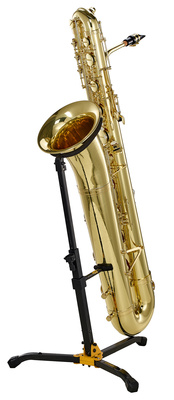The bass saxophone is especially popular in brass bands and for dramatic background music in film scores. It belongs to the lower-sounding saxophones. Due to its size and enormous weight, the bass saxophone is more suitable for advanced players.
What is characteristic of the bass saxophone?

The bass saxophone is the third lowest saxophone. Like any other saxophone, it belongs to the transposing instruments. This means that the notation does not correspond to the sounding tone. Since the bass saxophone is tuned to Bb, a notated C sounds like B1. It is also very large and weighs several kilos. The size also means that a large lung volume is needed to play the instrument. It is therefore difficult to handle and not recommended for saxophone beginners and children.
The body, which is bent several times, is characteristic of the bass saxophone. This runs directly behind the neck, once in a complete loop, and then merges into the usual lower bend of the main tube. This lengthens the bell, which produces the low tone. The neck, on the other hand, runs very straight, almost at a 90 degree angle.
For whom is the bass saxophone suitable?
The bass saxophone is hardly used melodically. It is therefore not suitable as a solo instrument. In the orchestra, however, it is indispensable with its deep, booming sound. It also has its place in jazz and film music. The bass saxophone is therefore more suitable for advanced players who already have experience in playing and now want to make music in a group.
What does the bass saxophone sound like?
The bass saxophone is tuned to B flat, so it sounds a ninth (14 semitones) higher than the notes written down. The fretted C then sounds as Bb. The range of the bass saxophone is from (G1) As1 to e1. Among the various sizes of saxophone, it sounds third lowest. Only the contrabass saxophone and the subcontrabass saxophone sound lower. If you are looking for higher-sounding saxophones, you can find out about the alto saxophone or the soprano saxophone, for example.
Which equipment is there for the bass saxophone?
The different types of saxophones already sound different because of their size. But the player himself and the equipment also influence the sound. If you want to adapt your saxophone individually to produce a certain sound, you can try out different things.
The mouthpiece
Depending on the embouchure technique and physiological conditions, each mouthpiece sounds different. It is a good idea to try out different mouthpieces and find out which sound you like best. Many players also have a selection of mouthpieces that they can use depending on the sound they want. The mouthpieces differ in various ways:
- Path opening: The distance from the reed to the tip of the mouthpiece.
- Path length: The angle of the opening
- Material: wood, rubber, plastic, glass or metal (whether the material has an effect on the sound is, however, disputed).
The reed
In the saxophone, the sound is produced by the reed, which is made to vibrate by the air flow. For example, due to condensation from the breathing air, the reed becomes soft over time and tears. Then it must be replaced to maintain the sound quality. Basically, the reeds are made of wood, which is why the saxophone also belongs to the woodwind insturments. However, there are also reeds that are covered with a plastic layer. This is to increase their life span.
When choosing the blade, you should also pay attention to the right thickness. You can choose between the strengths 1 – 5, whereby 1 corresponds to a very thin reed and 5 to a very strong reed. The stronger the reed, the greater the force required to produce a sound. This means that you need a higher lung volume to play with a stronger reed. It therefore makes sense to approach the strengths slowly. The mouthpiece should also be adapted to the reed. The rule here is: the larger the mouthpiece’s orifice, the thinner the reed.
Cleaning kit for the bass saxophone
Since water gets into the saxophone through the breath, the material can quickly become damaged if it is not cleaned regularly. In the long run, this not only damages the instrument, but also affects the sound. Cleaning after each use is recommended to collect the condensation. In addition, surfaces and tone holes should be cleaned regularly and the corks on the mouthpiece and neck should be greased. With a cleaning set you are well equipped for these tasks. In it you will find:
- Soft cloths for drying the interior
- Polishing cloths for the outer surfaces
- Cork grease
- a mouthpiece brush
- Clay hole cleaner
Who produces bass saxophones?
There are many saxophone manufacturers. One of the best known is Thomann. There you can find high-quality instruments at affordable prices. However, since the bass saxophone is not a beginner’s model, prices starting at around 2500£* are normal. This model from Thomann is one of them: the body and keys are made of brass, and it is also lacquered with clear varnish. The scope of delivery includes a rollable case and a mouthpiece with reed screw, as well as a spike for comfortably laying down the bass saxophone.
Other well-known manufacturers are, for example, the Japanese manufacturer Yamaha or the German production Keilwerth.
FAQ: The Bass Saxophone
The bass saxophone sounds very low, it is tuned in Bb. Only the double bass and subcontrabass saxophones sound even lower.
You can get a bass saxophone from around 2500£*. Professional models, however, can quickly cost over 15000£*.
The bass saxophone is tuned in Bb. Its range extends from (G1) As1 to e1.
Because the bass saxophone is so big, it weighs about 6 kilos.












